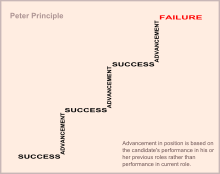Peter principle

The Peter principle is a concept in management theory formulated by Laurence J. Peter and published in 1969. The theory is that the selection of a candidate for a position is based on the candidate's performance in their current role, rather than on abilities relevant to the intended role. Thus, employees only stop being promoted once they can no longer perform effectively, and "managers rise to the level of their incompetence."
Overview
The Peter principle is a special case of a ubiquitous observation: Anything that works will be used in progressively more challenging applications until it fails. This is the "generalized Peter principle". There is much temptation to use what has worked before, even when this might not be appropriate for the current situation. Peter observed this about humans.[1]
In an organizational structure, assessing an employee's potential for a promotion is often based on their performance in the current job. This eventually results in their being promoted to their highest level of competence and potentially then to a role in which they are not competent, referred to as their "level of incompetence". The employee has no chance of further promotion, thus reaching their career's ceiling in an organization.
Peter suggests that "In time, every post tends to be occupied by an employee who is incompetent to carry out its duties"[2] and [the corollary] that "work is accomplished by those employees who have not yet reached their level of incompetence." He coined the term hierarchiology as the social science concerned with the basic principles of hierarchically organized systems in the human society.
He noted that their incompetence may be because the required skills are different, but not more difficult. For example, an excellent engineer may be a poor manager because they might not have the interpersonal skills necessary to lead a team.
Rather than seeking to promote a talented "super-competent" junior employee, Peter suggested that an incompetent manager may set them up to fail or dismiss them because they are likely to "violate the first commandment of hierarchical life with incompetent leadership: the hierarchy must be preserved".
Research
Alessandro Pluchino, Andrea Rapisarda, and Cesare Garofalo used an agent-based modelling approach to simulate the promotion of employees in a system where the Peter principle is assumed to be true. They found that the best way to improve efficiency in an enterprise is to promote people randomly, or to shortlist the best and the worst performer in a given group, from which the person to be promoted is then selected randomly.[3] For this work, they won the 2010 edition of the parody Ig Nobel Prize in management science.[4]
Comparable texts
José Ortega y Gasset suggested that: "All public employees should be demoted to their immediately lower level, as they have been promoted until turning incompetent".[5] Ortega died in 1955, about 14 years before Peter published The Peter Principle.
See also
- Dilbert principle
- Dunning–Kruger effect
- Founder's syndrome
- List of eponymous laws
- Murphy's Law
- Negative selection (politics)
- Office Space
- Parkinson's law
- The Peter Principle (TV series)
- Putt's Law and the Successful Technocrat
- Software Peter principle
- Systemantics
References
- ↑ Heylighen, F. (November 30, 1993). "The Generalized 'Peter Principle'". Principia Cybernetica Web. Retrieved April 11, 2014.
- ↑ Peter, Laurence J.; Hull, Raymond (1969). The Peter Principle: Why Things Always Go Wrong. New York: William Morrow and Company. p. 8. ISBN 0-688-27544-3. OCLC 1038496.
- ↑ Pluchino, Alessandro; Rapisarda, Andrea; Garofalo, Cesare (2009). "The Peter Principle Revisited: A Computational Study". Physica A. 389 (3): 467–472. arXiv:0907.0455
 . Bibcode:2010PhyA..389..467P. doi:10.1016/j.physa.2009.09.045.
. Bibcode:2010PhyA..389..467P. doi:10.1016/j.physa.2009.09.045. - ↑ "The 2010 Ig Nobel Prize Winners" (PDF). Annals of Improbable Research. 16 (6): 10–13. 2010.
- ↑ "En el umbral de la incompetencia". La Opinión (in Spanish). Retrieved November 30, 2013.
Bibliography
- Lazear, Edward P (October 12, 2000). "The Peter Principle: Promotions and Declining Productivity" (PDF). Hoover Institution and Graduate School of Business, Stanford University.